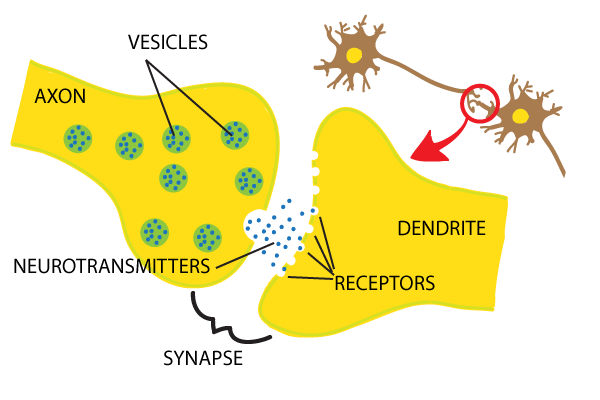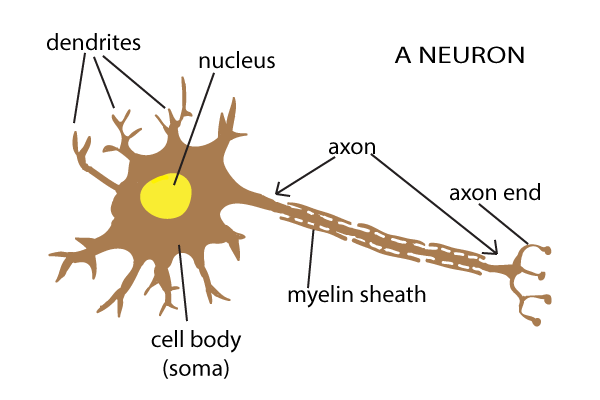The Snappy Synapse
This is the third article in a series on brain function and health, a topic dear to many with autoimmunity and inflammation. For the introduction, look at this post. For the second post, on brain structure and function, click here.
The brain is the most complex part of the human body. It is the home of our intelligence, interprets our senses, initiates body movement, and controls our behavior and emotions. More has been learned about the human brain in the last two decades than in all the time before, yet still we actually know very little about it.
The brain and nervous system are composed of numerous types of cells, but the primary cell in the brain is the neuron. Neurons are specialized nerve cells that engage in a complicated system of electrical and chemical communication to manage the body’s processes. We have between 86 billion and 100 billion neurons in the brain, and depending on our age and development, a human may have anywhere between 1 quadrillion and 10 quadrillion messages traveling through it an any one time! The smaller number is for adults, but don’t fret; later on in this series we’ll talk about how to maximize brain power as we age.
The Magnanimous Neuron
Neurons are specialized nerve cells that make up our brain and nervous system. They are in charge of processing and transmitting information through electrical and chemical signals. Like other cells, they have a surrounding membrane, a cell body (called the soma) with a nucleus, and they contain cytoplasm, mitochondria and other small parts. Yet neurons are different from other cells, in that they have two additional parts; extensions called dendrites and axons that transport electrical and chemical signals in and out of the cell.
Dendrites have branched, treelike ends called arbors that receive messages from other neurons. They are diverse in appearance; one may look like a seahorse, while another may appear like sea coral or a spider web.
While a neuron may have many dendrites, it has only one axon. The axon is a projection that sends messages to other neurons and cells. It is capable of building a network of extensions, also called arbors, to communicate with many cells at one time. There are anywhere from 1,000 to 10,000 inter-cellular connections for each neuron! The axon’s arbors can also be diverse; they may have a simple T shape, or they may be multi-branched. They can be quite short (less than a hair’s width), or they can be as long as three feet, like the axons of the sciatic nerve that run along the back of the thigh.
Are neurons arranged randomly? No; recent research shows that neurons in the brain are organized in space to minimize the lengths of the axons needed to connect them – possibly to pack more neurons into the brain and thus increase its processing capability.
Since this is a blog about autoimmunity, I’d like to give a shout-out to some special cells that help the axon. These cells include fatty molecules called myelin, which wrap around the axon, providing insulation that helps the electrical signals pass more quickly and farther. Degradation of the myelin sheath – called demyelination – is something that those with Multiple Sclerosis struggle with. An abnormal immune reaction in MS is believed to initiate an attack on the myelin, resulting in lesions, or bare spots, and scarring along the nerve. Conduction of the nerve impulse is slowed or halted, and there can be “cross-talk” between nerves—abnormal nerve-to-nerve signaling, all capable of producing the neurologic signs and symptoms of MS.
Pass the Neurotransmitters, Please!
Neurons communicate with electricity and by passing along chemical messengers called neurotransmitters. The brain uses neurotransmitters to tell your body what to do, affecting heartbeat, breathing, digestion, mood, sleep, and more.
 When a neuron’s dendrite receives a signal from another neuron, an electrical signal passes to the end of the axon (the projection that sends messages), where it triggers neurotransmitters to jump across the gap between neurons. This gap is called the synaptic cleft. This space is so tiny, it’s measured in nanometers, or billionths of a meter. Once the neurotransmitter has crossed the gap, it binds to a special receptor molecule on the next neuron’s dendrite, passing along a message. Much like a key and a lock, receptors are distinctly shaped to selectively recognize a particular neurotransmitter, such as dopamine and serotonin (more on that in a future article about mood!). The entire region – end of the axon, gap and receiving end of the neighboring neuron – is called the synapse.
When a neuron’s dendrite receives a signal from another neuron, an electrical signal passes to the end of the axon (the projection that sends messages), where it triggers neurotransmitters to jump across the gap between neurons. This gap is called the synaptic cleft. This space is so tiny, it’s measured in nanometers, or billionths of a meter. Once the neurotransmitter has crossed the gap, it binds to a special receptor molecule on the next neuron’s dendrite, passing along a message. Much like a key and a lock, receptors are distinctly shaped to selectively recognize a particular neurotransmitter, such as dopamine and serotonin (more on that in a future article about mood!). The entire region – end of the axon, gap and receiving end of the neighboring neuron – is called the synapse.
This electrochemical cascade is passed along at lightning speed from neuron to neuron, enabling complex and continual communication to occur throughout the body, every moment of our lives. The nerve impulse that initiates the release of a neurotransmitter moves at up to several hundred miles per hour along the axon’s membrane!
Now you know the basics of brain structure and function, as well as how the cells of the brain communicate. In my next post, I’ll write about the role that neurotransmitters play in our daily lives. This will set the scene for learning about how imbalances in the neurotransmitters can play a hand in many of our autoimmune symptoms, including “brain fog,” depression and mood issues.
Resources:
Kharazzian, D. Why Isn’t My Brain Working. Carlsbad, CA: Elephant Press, 2013.
http://brainhealthbook.com/
Perry, Susan. “Neurotransmitters: How Brain Cells Use Chemicals to Communicate.” Brainfacts website, 5/16/11.
http://www.brainfacts.org/brain-basics/cell-communication/articles/2011/neurotransmitters-how-brain-cells-use-chemicals-to-communicate/
Perry, Susan. “Neurons: A Curious Collection of Shapes and Sizes.” Brainfacts website, 8/22/12.
http://www.brainfacts.org/brain-basics/neuroanatomy/articles/2012/neurons-a-curious-collection-of-shapes-and-sizes/
Aubele,Teresa, and Susan Reynolds. “Prime Your Grey Cells: Wiring your brain for happiness and success.” Psychology Today website, 9/22/11.
http://www.psychologytoday.com/blog/prime-your-gray-cells/201109/the-skinny-brain-fats
Freudenrich, Craig, and Robynne Boyd. “How Your Brain Works.” How Stuff Works website, (n.d).
http://science.howstuffworks.com/life/inside-the-mind/human-brain/brain2.htm
Randerson, James. “How Many Neurons Make a Human Brain? Billions Fewer Than We Thought.” The Guardian Website, 2/28/12.
http://www.theguardian.com/science/blog/2012/feb/28/how-many-neurons-human-brain
National Institute of Neurological Disorders and Stroke website, (n.d). “Brain Basics: Know Your Brain.”
http://www.ninds.nih.gov/disorders/brain_basics/know_your_brain.htm

The links to your first and second posts about neurotransmitters don’t work, would you please re-link them. Thanks for this series, I have Hashi’s and have been at a loss as to why I am suddenly unmotivated and prefer to isolate.
Hi Apelila;
Thanks for the heads up – I fixed the links. I plan to return to the brain series in early 2016. In the meantime, I recommend reading Dr. Datis Kharrazian’s book, “Why Isn’t My Brain Working.” It’s a big book but written for mere mortals like us, and had tons of helpful information. Good luck, and I hope you are feeling better!